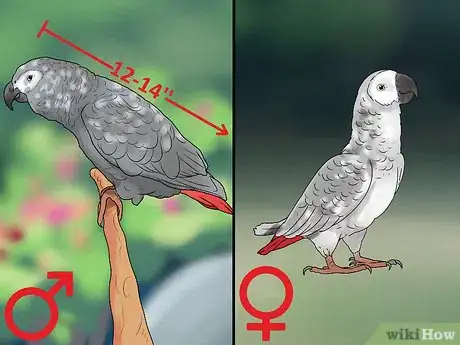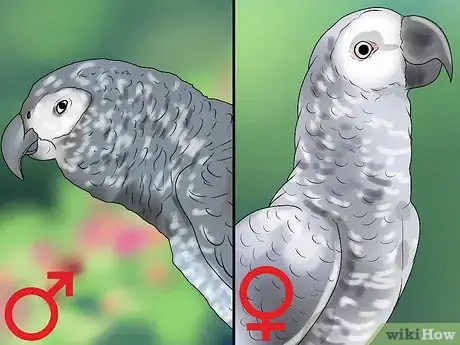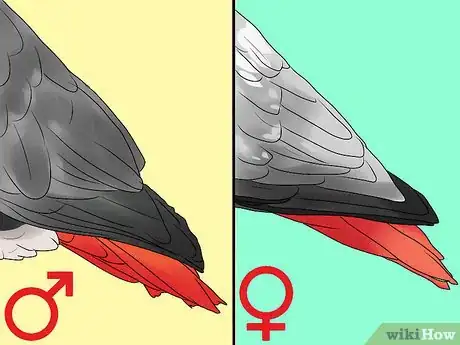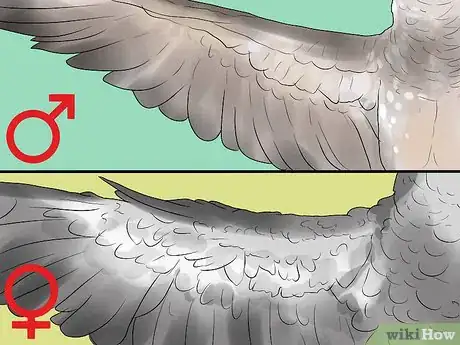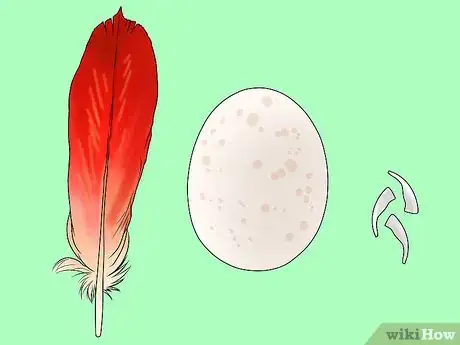This article was co-authored by Hayley Heartfield. Hayley Heartfield is a Bird Specialist and the Owner of About Birds, a Pet Bird Shop in Montgomery County, Texas. Hayley specializes in pet bird care, behavior, training, and breeding. Hayley studied Animal Science at Texas A&M. About Birds carries many species of birds and offers grooming and boarding services as well as bird care products.
There are 7 references cited in this article, which can be found at the bottom of the page.
wikiHow marks an article as reader-approved once it receives enough positive feedback. In this case, several readers have written to tell us that this article was helpful to them, earning it our reader-approved status.
This article has been viewed 196,650 times.
African Greys are smart, popular birds. It may be helpful to know the sex of your parrot if you intend to breed, or if you're introducing another bird and want to prevent breeding. In this article, we'll go over all of the different characteristics you can look for to determine the sex of your African grey parrot. We've also got tips on how to work with a professional to confirm the sex of your parrot if you want to be 100% certain.
Steps
Looking at Physical Characteristics
-
1Consider the body. There are slight differences in body type and size between males and females. First consider your bird's general body type to get a gauge of whether your bird is more likely male or female. From there, you can look at more subtle physical characteristics.[1]
- Males are usually 12-14 inches (30-35.5 cm) in height. Hens are generally somewhat shorter than this.[2]
- The body of a male African Grey is somewhat round, while females tend to be more slender.
- Males heads tend to be small and flat, and their necks are shorter. Females tend to have longer necks, with larger, rounder heads.
-
2Examine coloration. Males typically have a darker and more uniform color than hens. Females, on the other hand, have a gradual light-to-dark coloration from their neck to their belly.[3]
- This technique should only be considered in birds older than 18 months. A chick's feathers are still growing, so the color will change with age.
Advertisement -
3Examine tail feathers. Traditionally, male Greys have darker tail feather colors than hens. You need to check what are called the "ventral feathers." These are a set of about 10 feathers found directly under the bird's tail. You can pick up your African Grey and gently flip him or her over to examine the feathers.[4]
- Females will have ventral feathers that are edged in a shade of gray. Males will have ventral feathers that are solid red. There may be a small white hairline on male feathers.
- Keep in mind, this test is not accurate for young parrots. You cannot rely on tail feathers to determine sex unless your grey is 18 months of age or older.
-
4Check the wings. Observe your parrot when it is flapping its wings. You should be able to see three bands of gray on the underside of the wings. The colors of these bands are slightly different in males and females.[5]
- In females, the bands are usually gray, white, and dark gray. In males, the bands are usually gray, gray, and dark gray.
- As this difference is very slight, it can be hard to spot. You should look into other physical characteristics of an African Grey, in addition to wing color, in order to determine sex.
Consulting Experts
-
1Find a reputable avian specialist in your area. Avian specialists are trained vets whose primary focus is birds. The Association of Avian Veterinarians (AAV), and their website, provides information about finding a certified vet in your area.[6]
- You can also do a basic internet search for “avian vet in my area.”
- If you have other pets, talk to their vet. He or she might be able to refer you to a specialist or be able to conduct blood or DNA tests in house.
- Make sure your vet is certified with the AAV or American Board of Veterinary Practitioners (ABVP). They should be able to provide documentation to prove this.
-
2Have your avian veterinarian determine sex. A vet can use laboratory testing to determine the sex of your bird. It can be costly to take a bird in just for sex identification. However, you may need to know your bird's sex. If you're trying to breed, you will need a male and a female. If you're introducing a new Grey to your home and want to prevent breeding, you need to make sure the birds are of the same sex or look into neutering your grey.
- Vets often use endoscopies to determine sex. This is involves using a telescope to examine a bird's internal organs.[7]
- Your vet may have other laboratory means to test the sex of your bird. Sex testing methods depend on your bird's overall health and medical history, so talk over options with your vet.
-
3Conduct a DNA test at home. You may want a less invasive procedure to determine sex. With surgical and laboratory tests, there is always some risk of harm to your bird. You can acquire do-it-yourself DNA kit or blood card that you can mail in to get a DNA test for your parrot. These kits are easily assembled and easy to use.
- You can gather DNA from plucked feathers, eggshells, or toenail clippings. DNA collections from these samples are equally accurate as a DNA test from a blood sample.[8]
- You can talk to your vet to see if they can offer you this kit. However, be sure to get a certified DNA document from this testing.
- It is important to note that blood feathers nor molted feathers contain enough DNA data for accurate testing. You'll have to pluck feathers directly from your bird.
- You should get your test results pretty quickly. It takes about 2-3 business days. A testing kit will cost you around $15.00.[9]
Community Q&A
-
QuestionAren't both females and males supposed to have red tails?
 Community AnswerThe female African Grey parrot’s tail feathers are red, but they also possess silver hues; the tail feathers of the male African Grey is fully red.
Community AnswerThe female African Grey parrot’s tail feathers are red, but they also possess silver hues; the tail feathers of the male African Grey is fully red. -
QuestionWhy does the male parrot bite a female human?
 Community AnswerThey sometimes will bite anyone that it around their cage often. This is to show the human, in this case a female human, that they are the boss of their cage.
Community AnswerThey sometimes will bite anyone that it around their cage often. This is to show the human, in this case a female human, that they are the boss of their cage. -
QuestionWhat can I give to my bird when its feathers are pulled out?
 Community AnswerBirds feathers can get pulled out by mistake. This is normal if he isn't bleeding after pulling them out and is acting normal. He should be fine and the feathers will take about six weeks to grow back. If you are concerned or feel he is acting different, you should take him to the vet.
Community AnswerBirds feathers can get pulled out by mistake. This is normal if he isn't bleeding after pulling them out and is acting normal. He should be fine and the feathers will take about six weeks to grow back. If you are concerned or feel he is acting different, you should take him to the vet.
Warnings
- Always be careful when handling parrots. African Greys can cause some serious damage if annoyed or scared, so wait until your bird is calm and comfortable with you to handle him or her.⧼thumbs_response⧽
- The only way to be absolutely 100% sure of the sex of your African Grey is to do DNA testing.⧼thumbs_response⧽
References
- ↑ http://www.africangreyparrots.net/6-differences-male-female-african-grey-parrots/
- ↑ http://www.africangreyparrots.net/6-differences-male-female-african-grey-parrots/
- ↑ http://www.africangreys.com/articles/other/visually_sexing.html
- ↑ http://www.africanqueenaviaries.com/sexinggreys.htm
- ↑ http://www.africangreys.com/articles/other/visually_sexing.html
- ↑ http://www.aav.org/
- ↑ http://azeah.com/birds-chickens-cockatiels-cockatoos-macaws-parakeets-parrots-other-birds-waterfowl/endoscopy-avian
- ↑ https://vetdnacenter.com/dna-tests/avian-dna-testing/
- ↑ http://www.healthgene.com/avian-dna-testing/1306/
About This Article
To determine the sex of an African grey parrot, look at the feathers underneath its tail. If they're red, the parrot is a male, and if they're gray, it's a female. You can also tell what sex the parrot is by examining its head and neck. A male African grey parrot will have a small, flat head with a short neck, while a female African grey parrot will have a large, round head with a long neck. To learn how to get an expert opinion on the sex of your African grey parrot, scroll down!
